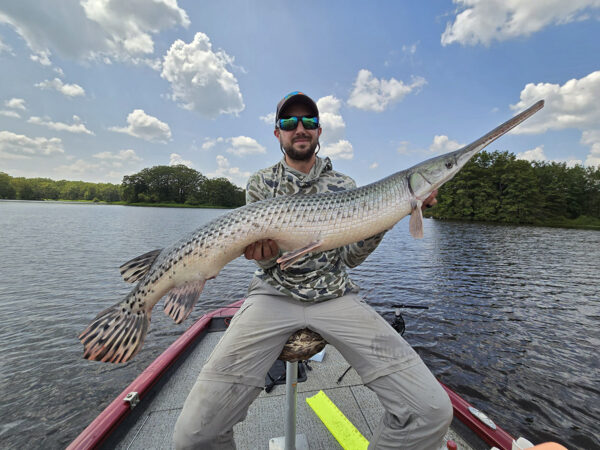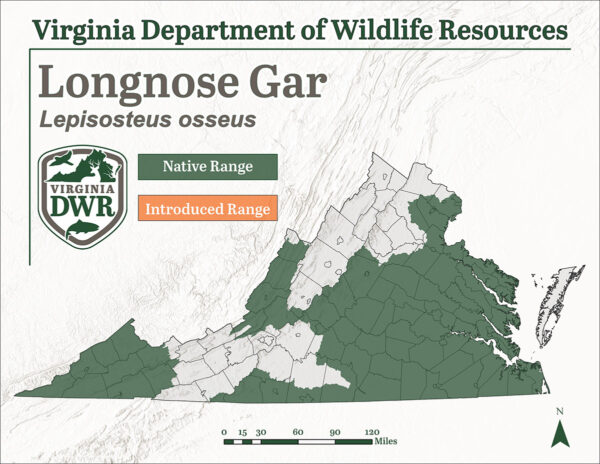Virginia DWR biologists process a large Longnose Gar during fish community sampling. ©Scott Herrmann - DWR
An angler poses for a quick picture with a Longnose Gar before releasing it. ©Tim Aldridge
Fact File
Scientific Name: Lepisosteus osseus
Classification: Fish, Order Lepisosteiformes, Family Lepisosteidae
Size: Longnose Gar in Virginia can surpass 50 inches in length
Life Span: Longnose Gar can live to about 20 years in Virginia
Identifying Characteristics

Virginia Master Angler Derek Merricks gets a quick photo with a trophy Longnose Gar before releasing it.
- A very long snout, with a mouth full of sharp needle-like villiform teeth
- Elongated body heavily armored in rhomboid shaped ganoid scales
- Dorsal fan set near the tail, directly above the anal fin
- Broad caudal fin that usually contains black spots or highlights
- Body color is predominately dark, but can range from nearly black to brown to olive
Diet
Longnose Gar are piscivorous, consuming a diet primarily comprised of other fish. As an apex predator of their environment, they will supplement with crayfish, crabs, small mammals and amphibians when an opportunity exists.
Distribution:
The Longnose Gar is native to Virginia, and can be found throughout the James, Potomac, Rappahannock, Roanoke, Upper Cumberland, Upper Tennessee, and York watersheds.

Habitat
Longnose Gar in Virginia thrive in lower gradient streams with deep pools and runs, reservoirs, and tidal estuaries. Longnose Gar hold in shaded areas with overhanging tree limbs and submerged structures. Longnose Gar are obligate air breathers, allowing them to survive in brackish waters and in areas with low dissolved oxygen. Their adaptations have allowed them to persist through many drastic climactic changes, with origins dating back to at least the Cretaceous Period (100+ million years ago).
Reproduction
Longnose Gar spawn in the spring, generally between April and June in Virginia. Longnose Gar eggs are adhesive, sticking to submerged aquatic vegetation, hard structure, and gravelly substrates as they get dispersed along shallower stream margins. Longnose Gar will occasionally utilize the bedding areas of other fishes, such as Smallmouth Bass. While the Longnose Gar does not exhibit any parental behavior post-spawn, their progeny may benefit from the protective instincts of individuals that originally constructed the spawning beds. Longnose Gar eggs incubate for up to 2 weeks. Juveniles have a disk-like structure on their snout that allows them to cling to submerged structure while they absorb their yolk-sack. Longnose Gar start to reach sexual maturity at 3 years of age.
Last updated: March 17, 2025
The Virginia Department of Wildlife Resources Species Profile Database serves as a repository of information for Virginia’s fish and wildlife species. The database is managed and curated by the Wildlife Information and Environmental Services (WIES) program. Species profile data, distribution information, and photography is generated by the Virginia Department of Wildlife Resources, State and Federal agencies, Collection Permittees, and other trusted partners. This product is not suitable for legal, engineering, or surveying use. The Virginia Department of Wildlife Resources does not accept responsibility for any missing data, inaccuracies, or other errors which may exist. In accordance with the terms of service for this product, you agree to this disclaimer.

